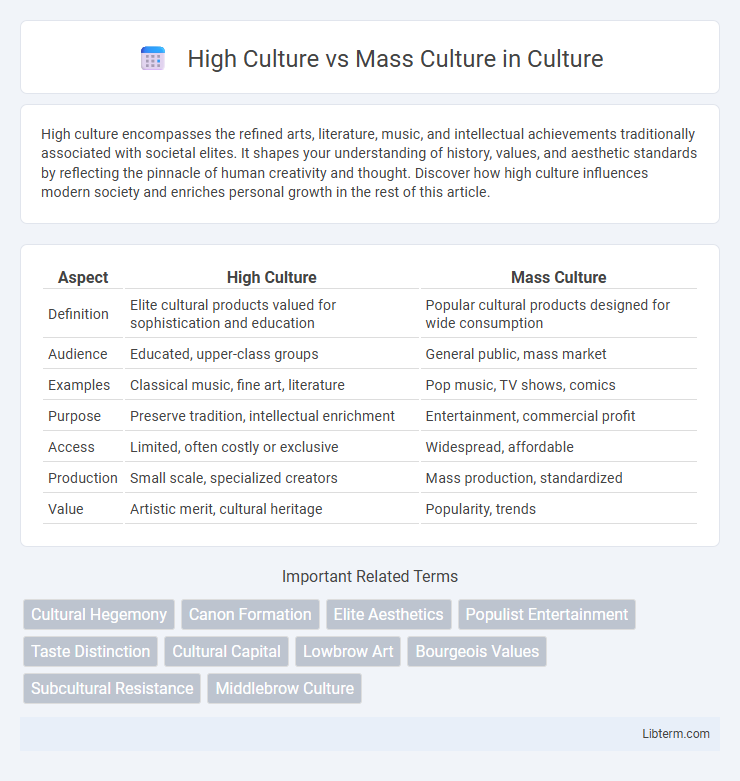High culture encompasses the refined arts, literature, music, and intellectual achievements traditionally associated with societal elites. It shapes your understanding of history, values, and aesthetic standards by reflecting the pinnacle of human creativity and thought. Discover how high culture influences modern society and enriches personal growth in the rest of this article.
Table of Comparison
| Aspect | High Culture | Mass Culture |
|---|---|---|
| Definition | Elite cultural products valued for sophistication and education | Popular cultural products designed for wide consumption |
| Audience | Educated, upper-class groups | General public, mass market |
| Examples | Classical music, fine art, literature | Pop music, TV shows, comics |
| Purpose | Preserve tradition, intellectual enrichment | Entertainment, commercial profit |
| Access | Limited, often costly or exclusive | Widespread, affordable |
| Production | Small scale, specialized creators | Mass production, standardized |
| Value | Artistic merit, cultural heritage | Popularity, trends |
Defining High Culture and Mass Culture
High culture encompasses classical music, fine arts, and literature traditionally valued by elite societies for its intellectual and aesthetic quality. Mass culture refers to popular entertainment, media, and consumer goods designed for broad public consumption, often driven by commercial interests. The distinction highlights differences in perceived cultural value, access, and social function.
Historical Evolution of High Culture vs Mass Culture
High culture historically emerged from elite institutions such as classical art, literature, and philosophy, often associated with aristocratic and intellectual circles since the Renaissance period. Mass culture developed alongside industrialization and urbanization in the 19th and 20th centuries, driven by technological advancements in printing, radio, cinema, and later digital media, which democratized access to cultural products. The evolution of high culture versus mass culture reflects ongoing tensions between exclusivity and accessibility, with contemporary cultural landscapes increasingly blending elite traditions with popular entertainment forms.
Key Characteristics and Examples
High culture is characterized by classical music, fine arts, literature, and intellectual pursuits associated with elite social groups, exemplified by opera houses, art museums, and canonical literary works. Mass culture involves popular entertainment forms such as television shows, pop music, and blockbuster films that appeal to a broad audience and are widely disseminated through mass media. Key distinctions include exclusivity and refinement in high culture versus accessibility and commercialization in mass culture.
Social Class and Cultural Consumption
High culture typically associates with upper social classes, emphasizing exclusive consumption of fine arts, classical music, and literature, reinforcing social distinctions and cultural capital. Mass culture caters to broader audiences across social strata, offering accessible entertainment such as popular music, television, and mass-produced media, facilitating shared experiences but often criticized for homogeneity. The consumption patterns reflect and perpetuate social class divisions, where high culture signifies status and education, while mass culture emphasizes inclusivity and commercial appeal.
Role of Media in Shaping Culture
The role of media in shaping high culture versus mass culture involves the dissemination and reinforcement of distinct cultural values and norms. High culture media typically promotes classical art, literature, and intellectual content that appeals to a more educated and elite audience, while mass culture media targets a broad demographic with entertainment-focused content designed for widespread consumption. Media platforms influence cultural perceptions by framing narratives, highlighting specific cultural products, and shaping public engagement with both highbrow and popular cultural forms.
Accessibility and Exclusivity of High Culture
High culture is characterized by its exclusivity, often associated with elite institutions such as opera houses, classical music, and fine art galleries, which require specialized knowledge or education to fully appreciate. Accessibility to high culture is limited by socioeconomic factors, educational background, and cultural capital, creating a barrier that distinguishes it from mass culture. This exclusivity reinforces social stratification, as high culture serves both as a symbol of status and a means of preserving traditional cultural values among privileged groups.
The Influence of Mass Culture on Society
Mass culture significantly shapes societal values and behaviors by promoting widely accessible entertainment and shared experiences, often leading to the homogenization of tastes. The pervasive reach of media, advertising, and popular trends creates common cultural references that transcend regional and social boundaries. This influence can dilute traditional high culture while fostering inclusivity and collective identity in diverse populations.
Cultural Criticism: Debates and Perspectives
High culture, often associated with elite art forms such as classical music, fine arts, and literature, is praised for its intellectual depth and artistic complexity, while mass culture encompasses popular media and entertainment consumed by the broad public. Cultural criticism debates center on the value hierarchies between these categories, questioning whether mass culture dilutes artistic quality or democratizes cultural participation. Critics like Theodor Adorno argue mass culture promotes passive consumption and cultural homogeneity, whereas contemporaries emphasize its role in reflecting diverse experiences and fostering social cohesion.
Globalization and Cultural Exchange
Globalization accelerates the interaction between high culture--traditionally elite artistic and intellectual pursuits--and mass culture, which encompasses widely accessible entertainment and consumer goods. Cultural exchange driven by digital media and international trade blends elements of high culture with popular culture, challenging the boundaries and accessibility of both. This dynamic fosters new hybrid forms of expression, reflecting diverse global influences while reshaping cultural hierarchies.
The Future of High Culture and Mass Culture
The future of high culture and mass culture lies in the increasing convergence driven by digital innovation and global connectivity, blurring traditional boundaries between elite artistic expressions and popular entertainment. High culture institutions are leveraging technology to broaden accessibility, while mass culture incorporates elements of sophistication and artistic value, fostering hybrid cultural forms that resonate across diverse audiences. This evolving dynamic challenges rigid classifications and promotes a more inclusive cultural ecosystem that values both historical depth and contemporary relevance.
High Culture Infographic

 libterm.com
libterm.com